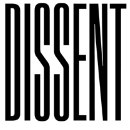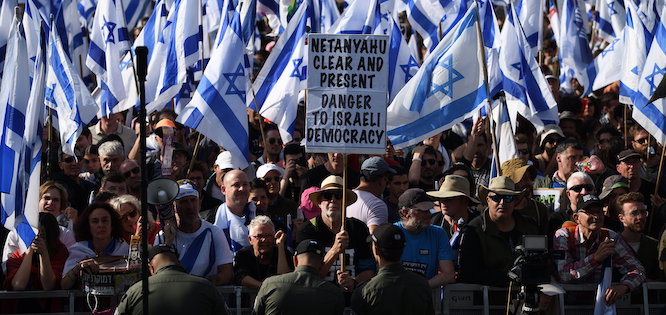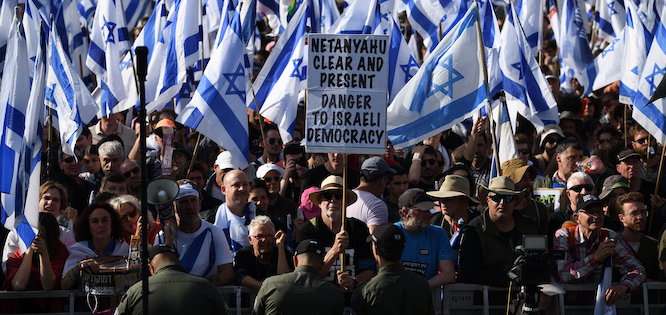
It is a mistake to ignore the connection between the attempted judicial coup in Israel and the occupation of the West Bank.

For over three months, a battle has raged on the streets of Israeli cities against the recently installed government led by the country’s longest-serving prime minister, Benjamin Netanyahu. This government is more right-wing and more religious than Netanyahu’s previous coalition governments; indeed, it is the most right-wing governing coalition that Israel has ever had, composed of Netanyahu’s Likud Party, two ultra-Orthodox parties, and three far-right, settler-dominated parties.
It is not only the small and shrinking group of leftists who typically demonstrate against right-wing Israeli governments that has been fighting this battle. They have been joined by hundreds of thousands of Israelis, many of them centrist and even conservative, who have poured into the streets, week after week, in growing numbers. Nearly one in five Israelis—the equivalent of over 60 million Americans—have joined in, including groups that have never been politically active before, such as the country’s affluent high-tech workers, medical professionals, high-ranking former security officials, and even employees of Israel’s intelligence agency Mossad.
Although Israel has seen many mass protest movements—for example, the 2005 protest movement against Israel’s disengagement from Gaza and the 2011 tent protest movement for social justice—the current movement is probably the largest and most diverse in its history. And while there have been massive street demonstrations before—most notably in 1982 following the Sabra and Shatila massacre of the first Lebanon War and in 1999 by ultra-Orthodox Jews protesting the Supreme Court—they were not repeated on a weekly basis, as the current demonstrations have been since January. The endurance and spread of these demonstrations across the country has surely surprised Netanyahu and his government.
This sudden outpouring of popular protest has been provoked by the government’s plan to, they say, “reform” Israel’s judiciary. Their plan is in fact a frontal assault on the independence and power of the judiciary, aimed primarily at the Supreme Court and its prerogative of judicial review adopted in the 1990s under the leadership of then-Chief Justice Aharon Barak. Despite the fact that the Supreme Court has used this power sparingly—striking down a total of twenty-two laws—the Israeli right has persistently denounced its actions as judicial activism. Now, Netanyahu’s government wants to pass legislation that would effectively strip the power of judicial review from the Supreme Court by giving Israel’s parliament, the Knesset, the ability to overturn its rulings. According to the proposed legislation, only an absolute majority of the Knesset’s 120 lawmakers, rather than a supermajority, would be required to override the court. Since the government almost always has a majority in the Knesset, the legislation would essentially allow it to enact whatever laws it wants and completely prevents the court from striking down anything the government deems a “Basic Law.”
The Netanyahu government’s proposed legislation would change the composition of the committee that appoints judges, giving the government an automatic majority and thus control over all judicial appointments. Government ministers would be allowed to choose their own legal advisers, who are currently independent appointees. In short, the proposed legislation would significantly weaken Israel’s judicial system and give its government almost unlimited power. This might not seem antidemocratic—you might think that unelected judges should be prevented from vetoing laws passed by an elected government—but a strong, independent judiciary is not only necessary to maintain the rule of law, but also to safeguard the rights of all citizens, especially minorities, and to prevent a government from undermining or even abolishing democratic rule. If Israel’s Supreme Court is unable to defend the rule of law and the rights of all Israelis, then Israel will become at best a majoritarian, not a liberal, democracy. It might even cease to be a democracy altogether and turn increasingly authoritarian.
Public opinion polls show that most Israelis oppose the government’s proposals. They recognize that what the Netanyahu government is attempting is not really judicial reform, but a de facto constitutional coup, similar to what has occurred in countries like Hungary, Poland, and Turkey over the past decade. They fear that Israel will become an illiberal democracy, or even a dictatorship; a recent survey found that only 38 percent of Israelis are optimistic about the future of democracy in the country. This fear has driven the mass protests.
But the movement is not just a defense of Israeli democracy; it is a “battle for the soul and future of Israel,” as former justice and foreign minister Tzipi Livni recently put it. Most of the protesters—who are largely secular, middle-class Israeli Jews—fear that both their civil liberties and their way of life are at risk, and they worry that if Israel becomes less democratic, it will become more theocratic. They want to preserve Israel’s identity as a Jewish and democratic state, and they view the planned judicial overhaul as part of a broader effort to make Israel more Jewish and less democratic. This widespread sentiment is echoed in the rhetoric of the demonstrations, which emphasizes Israeli patriotism in its visual imagery dominated by Israeli flags and in the prominence of retired generals and military commanders.
In this respect, the overriding goal of the protest movement is fundamentally conservative, aimed at protecting the existing sociopolitical order against political extremists and religious fundamentalists who now feel empowered to overturn it (due, in part, to their alliance of convenience with a prime minister on trial for alleged corruption and desperate to avoid imprisonment). This is why the protesters are mostly secular. It is also why there have been relatively few Palestinian-Arab citizens of Israel at the demonstrations, despite the fact that they constitute about a fifth of the country’s population.
Although the participation of Palestinian-Arab citizens has been slowly growing, the dominant discourse of the protest movement does not resonate with them. They have long believed that, as the veteran Palestinian-Israeli politician Ahmed Tibi famously put it, “Israel is a democracy for Jews and a Jewish state for Arabs.” Israel’s Palestinian-Arab minority—which lived under military rule for the first two decades of Israel’s existence (from 1949 to 1966), faces persistent discrimination, and is largely excluded from political decision-making—has long regarded Israeli democracy as exclusionary and deeply flawed. Unlike Israeli Jews, they have long insisted that for Israel to be a genuine democracy, it must cease to be a Jewish state—certainly not what the current protest movement is demanding.
Nor is protecting the power and independence of Israel’s Supreme Court a cause that inspires and energizes Palestinian citizens of Israel, despite the fact that their rights would be most at risk if the Court is enfeebled; the government could, for instance, disqualify Arab political parties from running for parliament. In a 2022 survey, just 40 percent of Arab citizens expressed trust in the Supreme Court, down from 78 percent in 2012. This decline is understandable given the court’s refusal to strike down many illiberal laws that have targeted Arab citizens: notably, the Citizenship and Entry into Israel Law, the 2011 Nakba Law, the 2014 Admissions Committees Law, the 2016 Expulsion of MKs Law, and the 2018 Nation-State Basic Law, which effectively enshrined Arabs as second-class citizens.
For the protest movement to include more Arab citizens of Israel, it would need to address their concerns as well as those of Israeli Jews. Instead of idealizing Israeli democracy and mythologizing the Supreme Court as a bastion of liberalism, the movement could acknowledge the flaws in Israeli democracy and the imperative to improve it so that it genuinely works for all citizens of Israel, Jewish and non-Jewish alike. Such a discursive shift could alienate some Israeli Jews, but it could also herald the emergence of an egalitarian pro-democracy movement that reshapes Israeli politics by creating the basis for sustained Jewish-Arab political cooperation. The unprecedented participation of an Arab party (the United Arab List [Ra’am], led by Mansour Abbas) in the previous coalition government suggests that such a possibility exists.
There is, however, another issue that not only discourages Palestinian citizens of Israel from joining the protest movement but also calls into question the movement’s professed commitment to democratic principles and values: Israel’s military rule over approximately 3 million stateless, disenfranchised Palestinians in the West Bank. (Palestinians in Occupied East Jerusalem have at least the theoretical ability to receive Israeli citizenship and voting rights.) The occupation is now in its fifty-sixth year, with no end in sight. This repressive regime, which international and Israeli human rights groups now characterize as apartheid, has undoubtedly corroded democracy in Israel.
As long as a two-state solution to the Israeli-Palestinian conflict seemed possible, the tension, or contradiction, between Israel’s democratic identity and its occupation of the West Bank seemed temporary. But now that a two-state solution increasingly appears impossible, and successive Israeli governments have only entrenched the occupation and advanced the de facto annexation of most of the West Bank, it is more clear than ever that Israel cannot continue to rule the West Bank undemocratically and call itself a democracy. It must either fully enfranchise its Palestinian subjects or withdraw and accept Palestinian statehood. Needless to say, the Israeli government staunchly opposes both of these options, as do most Israeli Jews. In fact, the coalition agreements that Netanyahu signed in December with the far-right Religious Zionism and Jewish Power parties officially announce their intent to annex the West Bank. Moreover, the government’s recent decision to give Finance Minister Bezalel Smotrich, the leader of Religious Zionism, significant powers in governing large parts of the West Bank (the Civil Administration, Israel’s governing body in the West Bank, is now mostly under his authority) already amounts to de jure annexation, since Smotrich is a civilian politician, not an Israeli military official.
Indeed, a major reason why the government wants to eviscerate the Supreme Court is to ensure that it will not stand in the way of this annexationist agenda. Curbing the power of the court would pave the way for the Israeli right to implement its long-held goal of extending Israeli sovereignty over most, if not all, of the West Bank without granting Palestinians equal rights such as the right to vote in Israeli elections. Finally within reach, this cherished goal is why the far-right parties and the hardliners within Likud (such as the Justice Minister Yariv Levin, the architect of the judicial overhaul) have been so determined to enact the judicial overhaul now, whatever the costs. They believe that they have a historic opportunity to fulfill their political and religious mission of restoring Jewish sovereignty over Judea and Samaria, the biblical names for the West Bank.
To ignore the connection between the attempted judicial coup and the occupation and annexation of the West Bank is both an analytical and a political mistake. Unfortunately, it is a mistake the bulk of the protest movement in Israel has made so far. Although a small contingent of left-wing activists have been involved in the protests from the outset, waving Palestinian flags and holding placards with the slogan “No Democracy With Occupation,” the message of this “anti-Occupation bloc” has been drowned out in the demonstrations, with organizers discouraging anyone from displaying Palestinian flags. The general orientation of the protest movement has studiously avoided mentioning the occupation of the West Bank, whether out of an understandable desire to attract as many Israeli Jews as possible, or simply because many of the protesters do not perceive the ongoing occupation as having anything to do with Israeli democracy—a blind spot shared by many prominent, mainstream American Jews who have, uncharacteristically, publicly criticized the Israeli government’s judicial plan.
The protests’ narrow focus might have made strategic sense in the short term, but it will ultimately prevent the movement from achieving its aspirations. Even if it succeeds in forcing the government to completely scrap its judicial overhaul, which is currently only temporarily paused, the outcome—at best, a maintenance of the status quo—would fall far short of what is really necessary to save Israeli democracy. Stopping the judicial coup isn’t sufficient. It is also necessary for Israel to end its occupation of the West Bank and fully respect the rights of its Palestinian-Arab citizens.
With escalating violence in the West Bank and new discriminatory legislation targeting Palestinian citizens making its way through the Knesset, this may seem like a distant dream. But the astonishing mass mobilization over the past ten weeks shows the potential for a pro-democracy movement in Israel that includes Palestinian citizens and advocates for the rights of everyone living under Israeli rule. The current battle for Israeli democracy might then mark the beginning of a new popular struggle for democracy in Israel and Palestine.
Dov Waxman is the Rosalinde and Arthur Gilbert Foundation Professor of Israel Studies and the director of the Y&S Nazarian Center for Israel Studies at the University of California, Los Angeles. He is the author of four books: The Pursuit of Peace and The Crisis of Israeli Identity: Defending / Defining the Nation (2006), Israel’s Palestinians: The Conflict Within (2011), Trouble in the Tribe: The American Jewish Conflict over Israel (2016), and most recently, The Israeli-Palestinian Conflict: What Everyone Needs to Know (2019). His writing has also been published in the New York Times, the Washington Post, the Los Angeles Times, and the Atlantic, among other publications.




